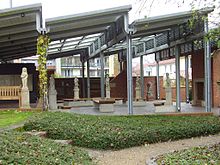Museum Nienburg
The Museum Nienburg / Weser is the regional museum for the history and archeology of the city and the district of Nienburg / Weser .
history
The Museum Nienburg / Weser has existed since 1903 and in 1908 it became the sponsorship of the museum association for the former counties of Hoya and Diepholz , based in Nienburg / Weser. At that time the association had 145 members, today (2014) there are around 750.
In 2018 the museum was awarded the museum seal of approval from the Museumsverband Niedersachsen und Bremen eV.
Exhibitions
The permanent exhibitions deal, among other things, with the Paleolithic Age , the old Saxon cemetery of Liebenau , asparagus cultivation, industrial culture and the art of New Objectivity . Special features are the Biedermeier garden , the lapidarium and the Lower Saxony asparagus museum. The Nienburg / Weser Museum is spread over various locations in the city of Nienburg.
Locations
Fresenhof
The 16th century Fresenhof ( location Museum Fresenhof ) was extensively modernized in 2014 and was temporarily closed to the public. Since its reopening, the permanent exhibition has shown a chronological tour through the archeology of the region and the history of Nienburg. Three exhibition areas have been set up: the Paleolithic to the Early Middle Ages , the Middle Ages to the present day and the display depot , in which exhibits from the early industrialization of Nienburg are shown. There are also special exhibitions here.
Quaet Faslem House
The house ( location Quaet-Faslem-Haus ) was named after its builder Emanuel Bruno Quaet-Faslem and houses the collection on Classicism in Nienburg. It is also used for a wide variety of events.
Lower Saxony Asparagus Museum
The Lower Saxony Asparagus Museum ( asparagus museum location ) in the Biedermeier garden of the Quaet-Faslem-Haus presents the history of asparagus cultivation in the region.
Also in the garden is the Lapidarium ( location Lapidarium ), a collection of hewn sandstones from the Central Weser area. The focus is on the 16th to 19th centuries.
Other fields of activity
Library and picture archive
The museum library has around 27,000 books and magazines in its holdings and is primarily a reference library. The reference inventory includes the particularly valuable and old issues and those whose state of preservation does not permit lending. You can borrow other parts of the library's holdings.
The image archive comprises around 28,000 photos, 7,000 postcards and around 17,000 slides. The image content can be researched using a keyword search in a database.
Study collection
The museum's collection is located in a separate storage building.
literature
- Kristina Nowak-Klimscha: Chronology - Limits - Progress - The new Museum Nienburg / Weser in: Archeology in Lower Saxony 18/2015, pp. 150–152
Web links
Individual evidence
- ↑ Nine museums are happy to receive a seal of approval from ndr.de on February 8, 2018





